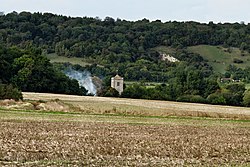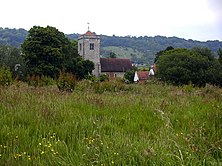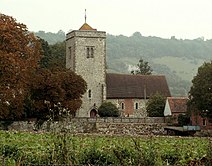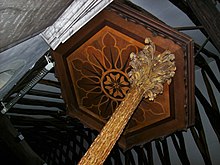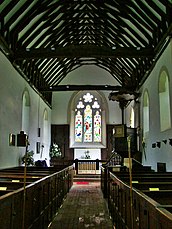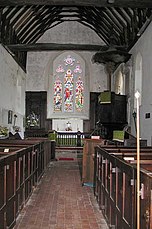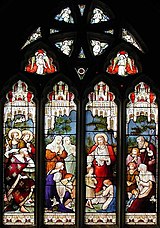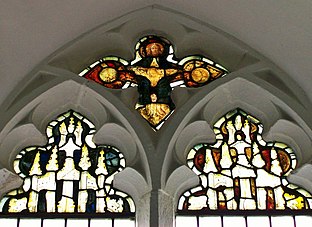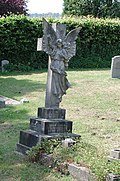
All Saints Church is in the small village of Weston-on-Avon, Warwickshire, England. The church is recorded in the National Heritage List for England as a designated Grade I listed building. It is an active Anglican parish church in the diocese of Gloucester, the archdeaconry of Cheltenham and the deanery of Campden. Its benefice is combined with those of St Swithin's, Quinton and St Peter's, Welford.

St Michael's and All Angels Church is in the village of Guiting Power, Gloucestershire, England. It is an active Anglican parish church in the deanery of Stow, the archdeaconry of Cheltenham and the diocese of Gloucester. Its benefice is combined with those of St Faith, Farmcote, St Mary, Lower Slaughter, St Andrew, Naunton, St Mary, Temple Guiting, St James, Cutsdean, and St Peter, Upper Slaughter. The church contains fabric dating from the 12th century and is recorded in the National Heritage List for England as a designated Grade II* listed building. It formerly stood in the centre of the village, but the demolition of buildings since 1900 has left it standing at the village's southern end.

St Peter and St Paul's Church is a redundant Anglican church in the hamlet of Preston Deanery, Northamptonshire, England. It is recorded in the National Heritage List for England as a designated Grade II* listed building, and is under the care of the Churches Conservation Trust. Although the church is not open for regular worship, it still hosts occasional special services, such as Pentecost and Christmas services for the Living Brook Benefice.

St Mary's Church is the parish church in Hadlow, Kent, United Kingdom. The church is a Grade II* listed building.

St Benedict's Church is a redundant Anglican church in the village of Paddlesworth, Kent, England. It is recorded in the National Heritage List for England as a designated Grade II* listed building, and is under the care of the Churches Conservation Trust. The church stands on the Pilgrims' Way, about 1 mile (1.6 km) west of Snodland.
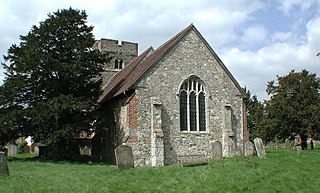
St Mary's Church is a redundant Anglican church in the village of Burham, Kent, England. It is recorded in the National Heritage List for England as a designated Grade I listed building, and is under the care of the Churches Conservation Trust. The church stands to the west of the village, on the Pilgrims' Way, overlooking the River Medway.

St Mary the Virgin is a parish church in Nettlestead, Kent, begun in the 13th century.

St Lawrence's Church is an Anglican parish church at Mereworth, Kent, United Kingdom. It is in the deanery of West Malling, the Diocese of Rochester and Province of Canterbury. The church was built in the mid-1740s by John Fane, the 7th Earl of Westmorland, following his removal of the village's 12th century place of worship to allow for the enlargement of Mereworth Castle.

St Peter's Church is in the village of Mansergh, Cumbria, England. It is an active Anglican parish church in the deanery of Kendal, the archdeaconry of Westmorland and Furness, and the diocese of Carlisle. Its benefice is united with those of six local churches to form the Kirkby Lonsdale Team Ministry. The church is recorded in the National Heritage List for England as a designated Grade II listed building.

St Mary the Virgin's Church is in centre of the village of Fawley, Buckinghamshire, England. It is an active Anglican parish church on the deanery of Wycombe, the archdeaconry of Buckingham, and the diocese of Oxford. Its benefice has been united with those of five other local churches to form the benefice of Hambleden Valley. The church is recorded in the National Heritage List for England as a designated Grade II* listed building.

The Church of the Good Shepherd is on Tatham Fell in Lancashire, England. It is an active Anglican parish church in the deanery of Tunstall, the archdeaconry of Lancaster and the diocese of Blackburn. Its benefice is united with those of St Wilfrid, Melling, St John the Baptist, Tunstall, St Peter, Leck, St James, Tatham, and Holy Trinity, Wray, to form the benefice of East Lonsdale. The church is recorded in the National Heritage List for England as a designated Grade II listed building.

St Nicholas is a Church of England parish church in Leeds, Kent first built in the 11th century with additions in the next five centuries. It is a Grade I listed building.

St Ambrose's Church is in the village of Grindleton, which is situated about 3 miles (5 km) northeast of Clitheroe, Lancashire, England. It is an active Anglican parish church in the deanery of Whalley, the archdeaconry of Blackburn, and the Diocese of Blackburn. Its benefice is united with that of St Peter and St Paul, Bolton by Bowland. The church is recorded in the National Heritage List for England as a designated Grade II listed building.

St Peter and St Paul's Church is in Gisburn Road, Bolton-by-Bowland, Lancashire, England. It is an active Anglican parish church in the deanery of Whalley, the archdeaconry of Blackburn, and the Diocese of Blackburn. Its benefice is united with that of St Ambrose, Grindleton. The church is recorded in the National Heritage List for England as a designated Grade I listed building.

St Mary's Church is a parish church in Hunton, Kent. It was begun in the late 11th or the 12th century and is a Grade I listed building.

St Peter's and St Paul's Church is a parish church in Yalding, Kent, dedicated to saints Peter and Paul. It was begun in the 13th century and is a Grade I listed building.

St Mary's Church is in the village of Acton Burnell, Shropshire, England, and stands near the ruins of Acton Burnell Castle. It is an active Anglican parish church in the deanery of Condover, the archdeaconry of Ludlow, and the diocese of Hereford. Its benefice is united with those of St Andrew and St Mary, Condover, St Mark, Frodesley, and St Michael and All Angels, Pitchford. The church is recorded in the National Heritage List for England as a designated Grade I listed building.
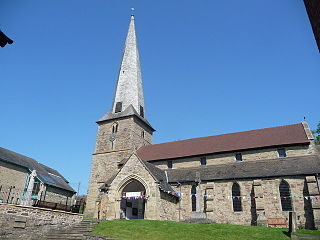
St Mary's Church is on Church Street, Cleobury Mortimer, Shropshire, England. It is an active Anglican parish church in the deanery of Ludlow, the archdeaconry of Ludlow, and the diocese of Hereford. Its benefice is united with those of six local parishes to form the Cleobury Benefice. The church is recorded in the National Heritage List for England as a designated Grade I listed building. It is notable for its shingled twisted spire.

St Peter's Church is in the grounds of Cound Hall, Cound, Shropshire, England. It is an active Anglican parish church in the deanery of Condover, the archdeaconry of Ludlow, and the diocese of Hereford. Its benefice is united with those of 13 other parishes to form the benefice of Wenlock. The church is recorded in the National Heritage List for England as a designated Grade I listed building.

St Peter's and St Paul's is a parish church in Teston, Kent. It is a Grade II* listed building and was rebuilt in 1736 for Sir Philip Boteler of Barham Court.


